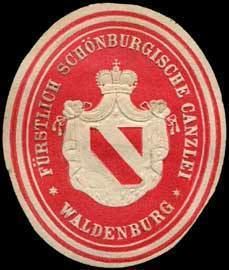 | ||
Schönburg (also Schumburg; Czech: ze Šumburka) is the name of an old European noble family, formerly with properties in present-day Saxony, Thuringia and Bohemia.
Contents
History
For several hundred years, the lords of Schönburg (Saale) have appeared in the history of southwestern Saxony, beginning in 1130, with the mention of Ulricus de Schunenberg (also Sconenberg).
Expansion of the house
The lords of Schönburg acquired several possessions over the centuries: Glauchau, where they had built a castle as an imperial fief around 1170, came into their ownership in 1256. They owned Lichtenstein since 1286, Waldenburg since 1378, the county of Hartenstein since 1406 and the lordships of Penig and Wechselburg since 1543. They received the lordship of Rochsburg Castle in 1548 in trade for Lohmen, Wehlen, Hohnstein and Kriebstein.
Jurisdiction and privileges
The territory of Schönburg overlapped into Saxony, Bohemia, and eventually Thuringia and all of it fell under the legal jurisdiction of the Holy Roman Empire of the German Nation. Consequently, the lords of Schönburg had different status in different areas under their possession, depending on whether there was over-lordship, and to whom. They were counted among the noble estates of the Holy Roman Empire of the German Nation, and to the landed estates in the Kingdom of Saxony. For their estates in the Kingdom of Bohemia, the counts of Schönburg were members of the Imperial College. On 7 August 1700, the collective house was raised to the status of Reichsgrafstand, or imperial county: its branches were consequently raised in status one and all . With this, members of the house received the predicate Illustrious Highness. The honor carried an important implication: the lordship was allodial, not a fief, thus the title, to the property and to the status, was inalienable (it could not be taken away). An allodial territory was a territory for which no feudal contract existed. It was subject to the emperor as sovereign but not to the emperor as overlord. Finally, at his coronation 9 October 1790, Leopold II raised the Waldenburg-Hartenstein branch of the family to the status of a princely house.
Mediatization in 1803 and 1806
After the Reichsdeputationshauptschluss in 1803, with many others of the nobility, the members of the house were named as Standesherren, and the family with once sovereign territorial lordship had to forfeit its judicial and legal rights, but retained its social and cultural standing as a sovereign family mediatized to Saxony. In 1818, the House petitioned the German Confederation to recognize the family; in 1828 the Parliament vouchsafed the personal and family rights that had been abrogated in 1806. The House was granted two seats in the Upper House of the Kingdom of Saxony in 1831. In 1878 they lost their last rights of partial sovereignty, however the King of Saxony decreed that all members of the family were to be known as Illustrious Highness.
The branches still today existing are the princes of Schönburg-Waldenburg (divided into the side branches Droyßig, Guteborn/Gusow and Gauernitz), the princes of Schönburg-Hartenstein (at Hartenstein, Stein and Lichtenstein) and the counts of Schönburg-Glauchau (formerly owning Glauchau, Penig, Wechselburg and Rochsburg). All family properties were confiscated in 1945 during the communist Land reform in East Germany. After the German reunification, however, Prince Alfred of Schönburg-Hartenstein (b. 1953) bought back Stein Castle and Prince Alexander of Schönburg-Hartenstein acquired Lichtenstein Castle. In 2008, he was elected chairman of the head organization of German nobility associations.
